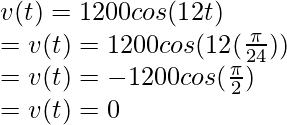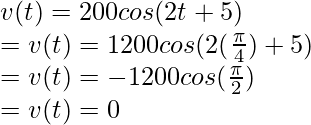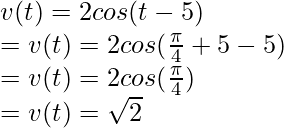简谐运动中的速度和加速度
简谐运动是一种周期性运动,它在一定时间段后自我重复。在现实生活中几乎随处可见,例如,与弹簧相连的物体在做简谐运动。了解物体的位置、速度和加速度等式至关重要。这些方程帮助我们从 SHM 中推断出有关对象的信息并预测其行为。让我们详细了解如何从 SHM 中提取此信息。
周期性和振荡运动
考虑一个昆虫试图爬上墙壁的例子,这种昆虫爬到一个高度,然后又掉下来。请注意,这种昆虫的运动会在一段时间后重复。这种运动称为周期运动。周期性运动在一定的时间间隔后重复。在图中,显示了一些表示周期性运动的图表。该图有一个重复的模式,这意味着对象的 y 位置周期性地增加然后减少。

周期性运动和振荡运动可能看起来相同,但它们有细微的差别。每个振荡运动都是周期性运动,但反之则不然。周期性运动只是在一定的时间间隔后重复自己,但振荡运动围绕平均位置来回移动。简谐运动是最简单的振荡运动类型。
简谐运动
简谐运动是一种周期性运动,物体围绕其平均位置来回移动。当作用在身体上的力与身体从其平均位置的位移成正比时,就会出现这种运动。在这种情况下,时间段保持不变。时间段用“T”表示,平均位置到极限位置的距离称为振幅,用 A 表示。摆动摆是简单谐波运动的一个例子。

物体在任何特定时间的位移 (x) 的一般方程由下式给出,
![]()
这里, ![]() 和
和![]() 表示相移。
表示相移。
类似地,SHM 中物体的速度方程可以通过对这个方程求微分得到。
![]()
然后,加速度方程变为,
![]()

请注意,在上图中,SHM 中的所有三个值位移、速度和加速度都与 SHM 具有相同的时间段,但它们之间的相位为 90°。
示例问题
问题 1:SHM 的方程如下所示。
x(t) = 5cos(2t)
计算最大加速度和速度。
回答:
General equation of SHM is given by,
![]()
In this case, A = 5, ![]()
Maximum velocity will be,
![]()
⇒ v = (5)(2)
⇒ v = 10 m/s
Maximum acceleration will be,
![]()
⇒ a = – (5)(2)2
⇒ a = -20 m/s2
问题 2:SHM 的方程如下所示。
x(t) = 10sin(5t)
计算最大加速度和速度。
回答:
General equation of SHM is given by,
![]()
In this case, A = 10, ![]()
Maximum velocity will be,
![]()
⇒ v = (10)(5)
⇒ v = 50 m/s
Maximum acceleration will be,
![]()
⇒ a = – (10)(5)2
⇒ a = -250 m/s2
问题 3:SHM 的方程如下所示。
x(t) = 100sin(12t)
计算 t = 的时间和速度![]()
回答:
General equation of SHM is given by,
![]()
In this case, A = 100, ![]()
We know,
Plugging the values into the equation,
![]()
⇒ ![]()
Equation for velocity will be found by differentiating the given equation,
x(t) = 100sin(12t)
⇒![]()
⇒ ![]()
At t = ![]()

问题 4:SHM 的方程如下所示。
x(t) = 100sin(2t + 5)
计算 t = 的时间和速度![]()
回答:
General equation of SHM is given by,
![]()
In this case, A = 100, ![]()
We know,
Plugging the values into the equation,
![]()
⇒ ![]()
Equation for velocity will be found by differentiating the given equation,
x(t) = 100sin(2t + 5)
⇒![]()
⇒ ![]()
At t = ![]()

问题 5:SHM 的方程如下所示。
x(t) = 2sin(t – 5)
计算 t = 的时间周期、加速度和速度![]()
回答:
General equation of SHM is given by,
![]()
In this case, A = 2, ![]()
We know,
Plugging the values into the equation,
![]()
⇒ ![]()
Equations for velocity and accelerations will be found by differentiating the given equation,
x(t) = 2sin(t – 5)
⇒![]()
⇒ ![]()
At t = ![]()

![]()
⇒![]()
⇒ a(t) = -2sin(t – 5)
At t = ![]()
